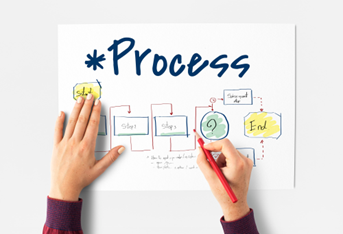If you’re struggling with a complex business process it can help to map it out. There are several commonly used techniques. If you’re new to it here are some simple steps to follow to get you started:
Identify Scope and Boundaries
Determine the scope of the process you want to model. Understand its boundaries and define what triggers the start & end of the process. Focus on the specific activities and interactions within the process.
Map the Process Flow
Start by mapping out the process flow from start to finish. Use a visual representation such as a flowchart or swimlane diagram to depict the sequence of activities, decisions, and interactions. Clearly define the inputs, outputs, and dependencies of each step.
Define Activities and Tasks
Break down the process into individual activities and tasks. Identify the actions that need to be performed at each stage and assign responsibilities to the appropriate individual or group. Consider including decision points, checkpoints, and approvals.
Document Inputs and Outputs
Document the inputs required for each activity or task, and the outputs produced. This helps to identify dependencies and ensures that all necessary information is available at the right stage.
Incorporate Business Rules and Decision Points
Identify any business rules or decision points within the process. These are conditions or criteria that guide the flow of the process and determine the next steps or actions. Clearly define the rules and decisions to ensure consistent and accurate execution.
Consider Exception Handling
Consider potential exceptions or deviations from the standard process flow. Define how these exceptions should be handled, including any alternative paths or additional steps required.
Use Notation or Modelling Language
Choose a notation or modelling language that best suits your needs. Commonly used notations include Business Process Model and Notation (BPMN) and Unified Modelling Language (UML). These notations provide standardised symbols and conventions for representing different elements of a process.
Validate and Review
Review the modelled process with key stakeholders, subject matter experts, or process owners to ensure accuracy and completeness. Incorporate feedback and make revisions.
Document Supporting Information
Document any additional information related to the process, such as process descriptions, roles and responsibilities, performance metrics, and associated documentation or forms.
Update and Maintain
A business evolves over time due to changes in technology, regulation, market conditions. Regularly review and update the process model to reflect any changes and ensure that it remains aligned with the current environment.
By following these steps, you can create a clear and comprehensive representation of a business process, enabling better understanding, analysis, optimisation, and communication among stakeholders. You can then transfer your model into a tool like Okuda to automate process flow and monitor progress. If you’d like help with process mapping drop us a message!

